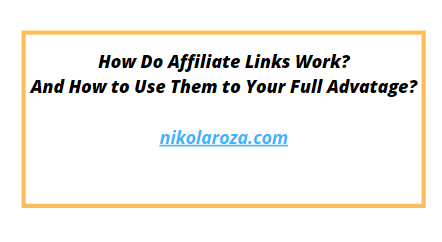Disclosure: Some of the links you’ll encounter are affiliate links. If you click and buy something, I’ll get a commission. If you’re reading a review of some precious metals company, please understand that some of the links are affiliate links that help me pay my bills and write about what I love with no extra cost to you. Thank you!
Hi there!
For some reason, most of the blog posts explaining how affiliate links work are talking about it from the consumers’ point of view.
Since my goal is to help educate affiliate marketers, I thought it wise to create a version that best serves you.
If you’re in the affiliate marketing space, then I’m sure you already know what affiliate links are; however you shouldn’t leave this page yet.
Because In this post; you will:
- not only learn what affiliate links are,
- but exactly how they work,
- and how to use them the right way to make more sales and blow up your affiliate earnings.
Excited to learn more?
Don’t answer it!
It was a rhetorical question 🙂

Table of Contents
What Are Affiliate Links Exactly? And How Do They Work?

Affiliate links look no different from any other link on a website. In fact they look exactly the same as their outbound and inbound brethren.
So, affiliate links too are used to connect web pages.
The only difference here is that affiliate marketers use their “special” links to monetize a website or a campaign. They hope that many a visitor clicks on their links; and that they proceed to buy something, thus earning a commission for the marketer.
Here is another special thing you need to know about affiliate links. They save cookies into the visitor’s browser.
What are cookies? Are they sweet? Can I eat them?
No you can’t 😉
Cookies are small files containing non-personalized information about the visitor.
Things like;
- type of browser,
- link visited,
- when did the click happen
- etc
Generally, the function of the cookies is to help the merchant’s website determine the website the customer came from. And if a sale occurs, that is how the merchant knows whom to pay out their affiliate commissions.
On average, cookies are active for 30 days. But there are plenty of exceptions.
For example, BlueHost gives you 90 days cookie duration; as a Fiverr affiliate you get a 30-day cookie; while Wealthy Affiliate University, (the program I’m promoting), gives you indefinite cookies.
Why is cookie duration so important?
Imagine a visitor clicks on your affiliate link, visits the web page, likes the product but decides not to purchase at that time. That must mean you have lost on commissions even if they went back directly and purchased later.
Right?
Well, no 😎
The beauty of cookies is that even if the visitor goes back and makes a purchase days later, the sale will be recorded under your account (as long as they don’t clear they cache and are not browsing in Private mode.)
Now let’s get into the actionable parts of the post.
How to Write Effective Content That Both Helps and Sells?
Just having your affiliate links slapped on a page will not guarantee success. Your content has to sell them on why it’s important to click; and what they’ll lose if they don’t.
So here’s how to achieve that;
Step #1- Research Keywords People Search for
Before you do anything, it’s vital to know who’s your audience and:
- what they want;
- what they need;
- what their pain points are?
Once you know that stuff, it’s easy to craft content that solves your reader’s problems, while also lining your pockets with affiliate commissions.
Now, here’s how to get unlimited blog content ideas
Use the Jaaxy keyword tool.
It’ll tell you what people search for and it will show you long tail keywords you need to stand a chance of ranking in Google.
For example here; what I get when I type “is coffee healthy”

That’s dozens of easy keywords, ripe for the taking!
Step #3- Chose a Keyword and Write a Post Targeting it
Once you’ve researched your keyword, make a decision and choose the one that you think would most resonate with your target audience.
While choosing a keyword, make sure to focus on long-tail keywords. In this day and age, there’s a stack of content online and it’s impossible to rank for short keywords.
So for example, you should never try to rank for “Coffee”
But you could and should target “is coffee healthy for weight loss”?
Pro tip
Put yourself in their shoes and try to think like they think. What do they REALLY want when they type keyword X into Google search? Approach it that way and you will easily create content that resonates with your tribe.
Pro tip #2
For any post you write on your website, always have a product you can promote in a subtle way. And one that ties in nicely with your blog post’s theme.
For example, I know that folks searching for “how do affiliate links work” are beginners and as such will benefit from studying for a training certificate that can teach them the basics of affiliate marketing. That is why throughout this post I promoted Wealthy Affiliate, a platform where I first started with online marketing.
They helped me, and I know they can help you too.
Step #3- Optimize Your Content With Basic On-Page SEO
As you write your article, it’s important to do basic on-page SEO right. It’s because these SEO elements are clues to Google on what you page is about and with higher relevancy, you will rank better, faster and with less backlinks needed.
Here’s on-page SEO in a nutshell:
- Keyword to SEO title-. SEO title is the single most important on-page SEO factor. You need to have your keyword in there
- Keyword in headline– good for SEO but also a clue to the visitors they’re on the right page.
- Keyword in the first 100 words of your content. Using your keyphrase early in the post helps Google understand your content’s topic better
- Keyword in sub-headline- this isn’t necessary; but it is helpful (however, it has to make sense- don’t stuff keywords where they don’t belong).
- Keyword in content– try to get your target keyword at least once in the middle and conclusion.
- Keyword in meta description. Not a ranking factor, but can boost your CTR (keyword in meta description get’s bolded in the SERPS)
For example, this blogger has his Tech Interview Pro review on his site.
And you can see for the image below that he’s optimized the heck out of it.

Step #4- Place Links Strategically Throughout Content
When placing your affiliate links in your content, you should be strategic and intentional about how you do it.
Here are some pro tips for you;
a) Make them isolated
Make sure your affiliate links are not competing with other links on the page. Isolate them to get maximum attention.
b) Affiliate links anchor text- make it descriptive and longer
When a link is descriptive it means it tells folks exactly where it leads. And when it’s descriptive it’s automatically longer which makes it more noticeable (especially if it’s a lone link in a sea of text).
c) Make them pop at you by creating a button in the middle of the post
Want to boost your CTR for a specific link? Then create a button to hold that link.
This will make it unavoidable to the eye and very click-worthy..
For example, the button below leads to my button making guide.
You see it because it’s impossible to miss it.
It’s not an affiliate link button, but no matter. The concept is still valid.
[maxbutton id=”13″]
3 Bonus tips for Better Link Management
#1-Cloaking Affiliate Links
In most cases, affiliate links are overly long and unsexy. It’s because they have so much information attached to them, including your all important affiliate ID code.
Here’s what I mean:

So, affiliate link cloaking is basically creating prettier version of the same link while keeping all the vital information intact.
The easiest way to cloak links is with WordPress plugins . And Thirsty Affiliates and Pretty Links rule supreme in that department.
Note: click the link above if you need to learn how and why to cloak affiliate links.
#2- No-Follow Affiliate Links
By nofollowing affiliate links, you’re telling search engines that they should not count them as backlinks, i.e., as votes for the merchant’s site. This saves you from a major headache of getting a search engine penalty.
The good news is, if you use link cloaking plugins I mentioned above, you can set them up so they automatically nofollow cloaked links.
#3- Try Banner Ads for Increased CTR
Use banner ads sporadically. They really don’t work as they used to in the past and the keyword here is “sporadically”.
However, having some is better than having none, and there are ways banners can work for your affiliate site.
So you get an increase in sales while keeping you site high quality and not just another thin affiliate site.
Frequently Asked Questions About Affiliate Links
a) How Do I Promote Products Successfully
Tie them closely to your article. If your post is about overcoming X problem, than the product you promote needs to help them do just that.
This way your affiliate links are not some extraneous things no one wants to look at; but are an integral part of the post and solution to the problem someone is facing.
Do affiliate marketing by adding some more value and you can’t go wrong.
b) How Do I Sign up For an Affiliate Network?
What merchant you choose is going to depend on the niche you’re in. So there’s atonne of ways to sign up a each merchat is slightly different.
However the basic steps stay the same and they are
- Identify the product you want to promote
- Sign up with an affiliate network or the product’s native affiliate program
- Get your affiliate links
- start promoting
- Collect earning from your affiliate dashboard
c) What is First Click/Last Click Affiliate Battle?
Imagine this:
You have a visitor, they browse around, read, enjoy and click on you affiliate link. Their cookie is recorded as coming from you so when they buy you will get a commission.
Great!
But then tomorrow, they visit another site and click on another webmaster’s link.
And now their cookies are in the mix.
Who wins when the person buys? Who rakes commissions and who is left in the dust screaming that LIFE’S UNFAIR!
Ok, I know I made that a bit over over the top, but the answer is- it depends.
Some merchant would attribute the sale to you while others to that other persons.
NO way to control it so don’t obsess over it too much.
Instead, go and make so many affiliate commissions that it won’t matter if you lose some.
Conclusion- I Trust You Now Know Everything You Should Know About Affiliate Links?
It’s really easy to jump into affiliate marketing and just start throwing links left, right and center.
But… it’s going to be worth your while to stop for a moment and learn to do things the right way.
So, now that you know what affiliate links are, you might also want to go and:
Yeah, education never stops and the fun has just begun!
I’d like to hear from you.
Shoot me a comment below.
Thanks 😀
Nikola Roza
Nikola Roza is a blogger behind Nikola Roza- SEO for the Poor and Determined. He writes for bloggers who don't have huge marketing budget but still want to succeed. Nikola is passionate about precious metals IRAs and how to invest in gold and silver for a safer financial future. Learn about Nikola here.
